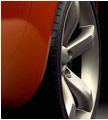GM R&D's history of innovation began
back in 1920, when the legendary Charles F. "Boss"
Kettering organized GM's first research lab. He dedicated
the lab to "intensive study of the problems ahead for
the automotive industry."
Over the years, we've put many of those "problems
ahead" behind us and turned to face new issues. Take
a look and you'll see hundreds of accomplishments over eight
decades, from anti-knock gasoline additives to injury tolerance
data to computer vision systems to drive-by-wire vehicles
to much, much more.
As Kettering said, research can be defined as "trying
to find out what you're going to do when you can't keep
on doing what you've been doing."GM Research remains
committed to intensive study to tackle the challenges of
our industry now and in the future.
What advanced technologies could you
develop at GM Research?
Accomplishments over the Years
1920s: First anti-knock gasoline additives - led
to high-performance fuels
1930s: First non-flammable, low-pressure refrigerants,
which made vehicle and home refrigerators practical
1940s: First high-compression, internal-combustion
engines
1950s: America's first turbine-powered car; forerunner
of present-day computer operating systems
1960s: Pioneering work on experimental powerplants:
gas turbines, steam, free piston, and Stirling engines;
electric drive; and hybrids; first comprehensive data on
human injury tolerance
1970s: Zirconia exhaust gas sensor - led to the
successful use of three-way catalysts; pioneering work on
atmospheric chemistry; first computer simulation of an automobile
crash
1980s: Magnequench rare-earth permanent magnets;
industry-leading computer vision systems for manufacturing;
computer-based structural and acoustic analysis for vehicle
design
1990s: Integrated chassis control; series of modern
experimental vehicles: advanced electric, diesel-electric
hybrid, turbine-electric hybrid, compressed natural gas-fueled
and fuel cell-electric vehicles; Partnership for a New Generation
of Vehicles (PNGV); magneto-rheological fluids; Adaptive
MagnaSteer Variable-Effort Steering




